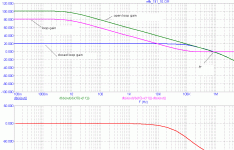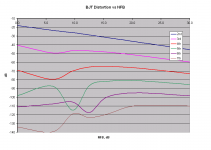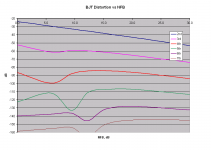john curl said:I didn't see the unbypassed 20.2 ohm resistor. What is that for?
Hi John,
It is local degeneration that gets the gain of the BJT stage into the same neighborhood as that of the JFET stage.
I figured we "always" use some degeneration with bipolars, but now that I see that Baxandall did not, I'll go back and see what the results look like without degeneration.
Cheers,
Bob
Bob Cordell said:Very interesting point. Looking at it that way, one could argue that the 18 dB of local degeneration gets us past the "bad" part of the NFB degree spectrum, out to where it is good.
I'll try some more sims to see if that makes sense.
Thanks again for all your help with using the SPICE Fourier analysis capability.
You're welcome! I think that with no degeneration, the sim results should correlate with Baxandall's measurements much better - my guess is much better than Baxandall's theoretical predictions match up. His theoretical predictions assume that only the cubed term of the transfer characteristic will affect the third harmonic, when the fifth, seventh, etc will also contribute somewhat. SPICE is of course not limited to that assumption.
PMA said:The 2nd: the same stage in OA (OPA134) feedback:
Now the same for LM741. Compared to OPA134, one can see how uneffective is cross-over distortion reduction in this case. The reason is very low frequency of the 1st rolloff breakpoint, resulting in low loopgain at higher frequencies. The 2nd reason is low slew rate.
Most of the concerns about feedback in the seventies were based on low SR and low fT. Of course there was a problem. But to disclaim feedback completely, based just only on these drawbacks was quite misleading.
Attachments
PMA said:
Now the same for LM741. Compared to OPA134, one can see how uneffective is cross-over distortion reduction in this case. The reason is very low frequency of the 1st rolloff breakpoint, resulting in low loopgain at higher frequencies. The 2nd reason is low slew rate.
Most of the concerns about feedback in the seventies were based on low SR and low fT. Of course there was a problem. But to disclaim feedback completely, based just only on these drawbacks was quite misleading.
Very true, indeed.
Bob
BJT distortion vs NFB - no degeneration
Here is the plot of distortion harmonics as a function of amount of NFB for a single-ended BJT with no degeneration in the same arrangement as Baxandall's.
Notice that the behavior is the same as Baxandall's graphs he obtained from lab measurements, including the roller-coaster behavior and "notches" at amounts of NFB below 20 dB.
This is very good news, because it suggests that SPICE can be used to answer these kinds of questions and that it can be used to explore the design space with some confidence.
It also shows that the presence of the degeneration in the earlier sims that I showed did indeed "mask" the effect of the NFB at low amounts of NFB, so in that regard I stand corrected and am appreciative that this behavior of the BJT in Baxandall's work was pointed out. This is how we all learn, even if sometimes we have to eat a little bit of crow.
But, remember, there is a silver lining here that still brings into question the position of the feedback-averse designers. In most real circuits, BJT stages have some degeneration that will make them behave very nicely as in my earlier simulations. Bear in mind that this circuit that shows this odd behavior and some NFB-enhancement of some distortion products is a completely undegenerated, single-ended, resistively-loaded BJT showing a gain of 200 and operated hard in terms of its signal current as a fraction of its bias current. Second harmonic distortion of this circuit without NFB is about 12%.
Also, look carefully at the vertical scale, that runs from -10 dB distortion all the way down to -140 dB. Above 20 dB of NFB, the 7th harmonic remains below -109 dB (0.00035%) across the board.
At least two interesting questions arize:
1) How much local degeneration is needed to get the circuit to the point where the application of NFB around it will only result in a monotonic decrease of distortion products?
2) If the application of degeneration is itself NFB, then do we see any enhancement of distortion products as a function of the application and increase of NFB when it is only in the form of degeneration?
Stay tuned.
Cheers,
Bob
Here is the plot of distortion harmonics as a function of amount of NFB for a single-ended BJT with no degeneration in the same arrangement as Baxandall's.
Notice that the behavior is the same as Baxandall's graphs he obtained from lab measurements, including the roller-coaster behavior and "notches" at amounts of NFB below 20 dB.
This is very good news, because it suggests that SPICE can be used to answer these kinds of questions and that it can be used to explore the design space with some confidence.
It also shows that the presence of the degeneration in the earlier sims that I showed did indeed "mask" the effect of the NFB at low amounts of NFB, so in that regard I stand corrected and am appreciative that this behavior of the BJT in Baxandall's work was pointed out. This is how we all learn, even if sometimes we have to eat a little bit of crow.
But, remember, there is a silver lining here that still brings into question the position of the feedback-averse designers. In most real circuits, BJT stages have some degeneration that will make them behave very nicely as in my earlier simulations. Bear in mind that this circuit that shows this odd behavior and some NFB-enhancement of some distortion products is a completely undegenerated, single-ended, resistively-loaded BJT showing a gain of 200 and operated hard in terms of its signal current as a fraction of its bias current. Second harmonic distortion of this circuit without NFB is about 12%.
Also, look carefully at the vertical scale, that runs from -10 dB distortion all the way down to -140 dB. Above 20 dB of NFB, the 7th harmonic remains below -109 dB (0.00035%) across the board.
At least two interesting questions arize:
1) How much local degeneration is needed to get the circuit to the point where the application of NFB around it will only result in a monotonic decrease of distortion products?
2) If the application of degeneration is itself NFB, then do we see any enhancement of distortion products as a function of the application and increase of NFB when it is only in the form of degeneration?
Stay tuned.
Cheers,
Bob
Attachments
Is this thread supposed for obsessed chanting of a mantra that the feedback is good?
Look, Baxandall measurements clearly show that for the same level of high order products as without feedback the cumulative loop (global and local) gain around the amplifying device should be at least 40 dB.
Look, Baxandall measurements clearly show that for the same level of high order products as without feedback the cumulative loop (global and local) gain around the amplifying device should be at least 40 dB.
I was curious to see what happens to the behavior of the undegenerated BJT above when it is not driven quite as hard. I therefore reduced the drive by 6 dB so the output is now 1.5 V peak.
The unusual behavior is still evident. Be sure to note the different distortion scale, which now ranges from -20 dB down to -160 dB. Under these conditions, we can still see NFB-enhancement of the 7th harmonic, but the seventh harmonic never gets above -145 dB.
Cheers,
Bob
The unusual behavior is still evident. Be sure to note the different distortion scale, which now ranges from -20 dB down to -160 dB. Under these conditions, we can still see NFB-enhancement of the 7th harmonic, but the seventh harmonic never gets above -145 dB.
Cheers,
Bob
Attachments
Notice that the behavior is the same as Baxandall's graphs he obtained from lab measurements, including the roller-coaster behavior and "notches" at amounts of NFB below 20 dB.
Bob, the level of 4th, 5th and 6th harmonic it the simulation are 10-20dB less than measured by Baxandall. I noticed a long ago that the SPICE gives too optimistic figures, so I don't use it for nonlinearity analysis.
Bob Cordell said:
The unusual behavior is still evident. Be sure to note the different distortion scale, which now ranges from -20 dB down to -160 dB. Under these conditions, we can still see NFB-enhancement of the 7th harmonic, but the seventh harmonic never gets above -145 dB.
Cheers,
Bob
Very very interesting, indeed. It is also very important that you speak in absolute terms - "seventh harmonic never gets above -145 dB", rather than point to enhancement without any quantification.
Pavel
Where is the notch at 3dB feedback in the third harmonic? The math says that it should be there.
dimitri said:
Look, Baxandall measurements clearly show that for the same level of high order products as without feedback the cumulative loop (global and local) gain around the amplifying device should be at least 40 dB.
This should be a rule of thumb!
AT LEAST 40dB
dimitri said:Is this thread supposed for obsessed chanting of a mantra that the feedback is good?
Is there any proof that PROPERLY USED feedback is not good?
Pavel, I forgot to put one more word:
Is this thread supposed for obsessed chanting of a mantra that the feedback is ALWAYS good?
Now the question is to define what PROPERLY USED feedback is.
Is this thread supposed for obsessed chanting of a mantra that the feedback is ALWAYS good?
Now the question is to define what PROPERLY USED feedback is.
dimitri said:Is this thread supposed for obsessed chanting of a mantra that the feedback is good?
Look, Baxandall measurements clearly show that for the same level of high order products as without feedback the cumulative loop (global and local) gain around the amplifying device should be at least 40 dB.
Hi Dimitri,
No, the thread is to promote discussion of negative feedback, be it high or low, or no NFB, with all of its advantages and disadvantages, and the subtleties of its application.
The intent is to confront the controversies head-on, wherever that may lead.
Part of that journey is to better understand under what conditions Baxandall's findings apply, and where they may not apply. Your simple generalization above may ultimately be true, but that does not in and of itself make NFB bad. Degeneration is something that both NFB and non NFB designers use readily.
BTW, my first set of graphs for the degenerated BJT stage would seem to suggest that the magic cumulative number is only equal to or less than the amount of degeneration I used in that case, which was about 19 dB (since those graphs had monotonically decreasing distortion spectra as NFB was increased). That is a far cry from your 40 dB number.
The role of emitter degeneration may need more study.
Cheers,
Bob
dimitri said:
Bob, the level of 4th, 5th and 6th harmonic it the simulation are 10-20dB less than measured by Baxandall. I noticed a long ago that the SPICE gives too optimistic figures, so I don't use it for nonlinearity analysis.
Just don't throw the baby out with the bathwater.
That the behavior shows the same rollercoaster and occasional NFB enhancement of the distortion is what is most important here. The absolute numbers are less important. Moreover, I certainly agree that SPICE is likely to be a bit optimistic compared to the real world for a number of reasons. I would never claim that I had designed an amplifier capable of 0.001% THD-20 based only on SPICE simulations.
Cheers,
Bob
john curl said:Where is the notch at 3dB feedback in the third harmonic? The math says that it should be there.
Hi John,
The lowest amount of NFB that I simulated and got a data point for was 6 dB. So a notch at 3 dB NFB might have been missed.
Bob
dimitri said:Pavel, I forgot to put one more word:
Is this thread supposed for obsessed chanting of a mantra that the feedback is ALWAYS good?
Now the question is to define what PROPERLY USED feedback is.
Good point. Negative feedback is NOT always good. There are plenty of designers out there fully capable of screwing it up.
By the same token, no NFB is NOT always good. There are plenty of designers out there fully capable of screwing up a design in the complete absence of NFB.
Present company excluded, of course 🙂.
Cheers,
Bob
dimitri said:Pavel, I forgot to put one more word:
Is this thread supposed for obsessed chanting of a mantra that the feedback is ALWAYS good?
Now the question is to define what PROPERLY USED feedback is.
what's your issue dimitri?
I think we've mentioned that feedback can't fix an amp with dead zone or extend its response beyond current and voltage capabilities of the devices or circuit, these include dynamic limits such as slew rate and base charging
when these hard nonlinearities are encountered feedback can make bad worse by "trying too hard", clipping internal stages, extending recovery times, or going into nonlinear oscillations and techniques exist for limiting some of the bad behavior
but applied to a basically competent circuit feedback is our most powerful design technique for improving accuracy, reducing device tolerance effects on response variability, controlling in/out impedance, reducing distortions...
the current discussion of small amounts of feedback effect on distortion spectra is interesting but I keep putting numbers on the higher feedback situations to show that "distortion multiplication" principle has a very limited region of applicability - but it could explain some designers abandoning global negative feedback on the basis of trying just a little bit and encountering real increases in distortion
there is certainly much more sophisticated literature on feedback's limits for manipulating sensitivity/time/frequency response
anyone can download a fairly good book from:
http://www.eng.newcastle.edu.au/~jhb519/limits.html
(link near bottom of page)
Oops, link died, at least I have a copy - page should give enough search terms for the truely interested to find web content on the subject
- Home
- Amplifiers
- Solid State
- Bob Cordell Interview: Negative Feedback



